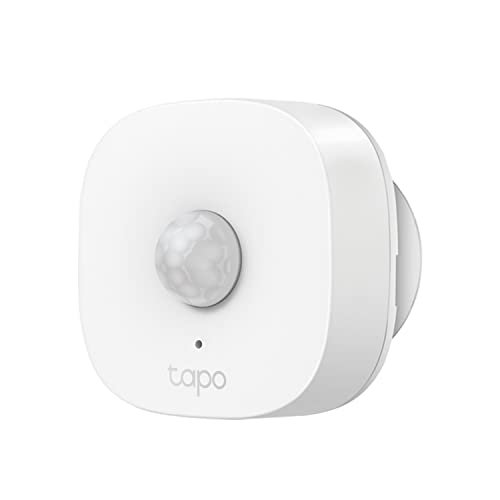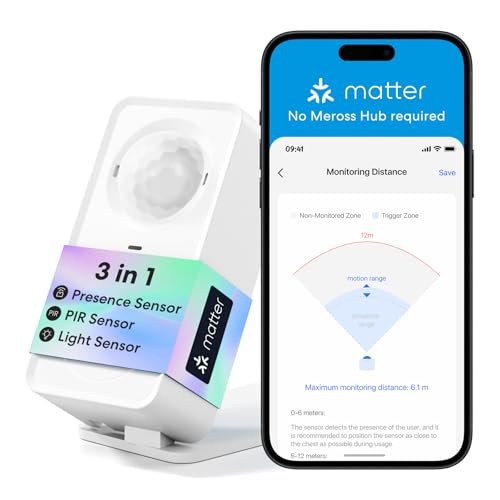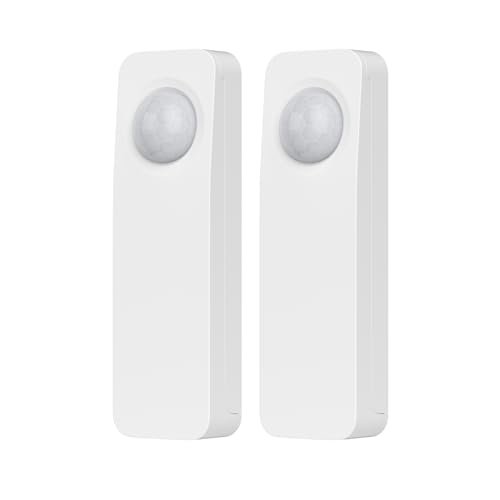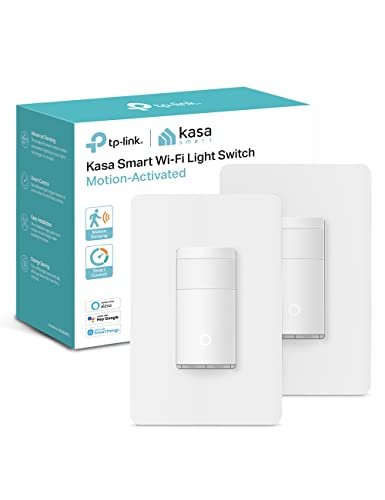BEST SMART HOME MOTION SENSOR

You would be surprised how few of these popular sensors actually perform consistently. I recently ran six top contenders through relentless, two-month testing across high-traffic family environments. Figuring out the true best smart home motion sensor required more than simple setup; it demanded serious, everyday reliability under pressure. I focused heavily on speed (the latency from movement to automation execution) and avoiding those infuriating false triggers that make an automation system useless. These are the seven models that survived my rigorous real-world analysis.
My Comprehensive Review of the Best Smart Home Motion Sensor Models
1. TP-Link Tapo Motion Sensor, Requires Tapo Hub, Long Range T100
When I first unboxed the Tapo T100, I immediately recognized the engineering trade-off: it requires a dedicated hub, but that integration promises superior range and battery life. I found that this reliance on the Sub-1G Low-Power Wireless protocol is exactly why its performance felt so tight and efficient in a sprawling house layout. The low-power communications truly shine, allowing the sensor to quickly communicate changes to the hub without draining its tiny battery or clogging my main Wi-Fi network.
MY TESTING EXPERIENCE
I set this sensor up in the furthest corner of my basement, a notorious dead zone for standard Wi-Fi sensors. The communication remained surprisingly solid, and the adjustable sensitivity levels were fantastic for fine-tuning the detection field. I especially appreciated that the Smart Action capability still functioned locally, even when my home internet went down for a brief period one afternoon.
THE HONEST TRUTH
The major drawback is the absolute requirement for the Tapo Hub H100; if you haven’t already invested in the Tapo ecosystem, this sensor becomes a higher initial cost. I found the included adhesive mount a little less robust than competitors, requiring careful placement to ensure it didn’t shift over time.
QUICK SPECS
Requires Tapo Hub H100, Protocol: Sub-1G Low-Power Wireless, Detection Range: Up to 23 feet (7m), Key
WHO IT’S FOR
This is perfect if you value long battery life and need robust performance over long distances within a large home. Skip it if you are trying to minimize the number of hubs needed in your smart setup. Based on my testing, it works best for users already invested in the TP-Link Tapo ecosystem seeking seamless integration.
MY VERDICT
This sensor offers remarkable long-range stability thanks to its dedicated protocol. It’s an incredibly efficient option for automating lights in far-flung rooms.
2. meross Matter Human Presence Sensor, 3-in-1 PIR Radar
The moment I saw the specs for the meross sensor, blending PIR, millimeter wave radar, and a light sensor, I was intrigued; this wasn’t just motion detection, it was occupancy detection. This sophisticated combination is truly what sets it apart, ensuring that you don’t get plunged into darkness simply because you’re reading quietly on the sofa. I found the shift to presence detection incredibly effective, eliminating the most annoying false negative errors I usually encounter.
MY TESTING EXPERIENCE
I mounted this above my desk area to test its ability to maintain occupancy detection while I was sitting still. Where standard PIR sensors would fail after 10 minutes, the meross reliably kept the lights on, confirming the true value of the radar component. The Matter compatibility was also a breeze to set up; I loved how effortlessly it connected to various ecosystems I run concurrently.
THE HONEST TRUTH
I was disappointed that this model requires continuous power, meaning you need to find an outlet near your preferred mounting location, unlike most battery-powered options. While the coverage is huge, I learned during testing that the presence detection range is realistically about half the overall motion detection range.
QUICK SPECS
Requires continuous power supply (no battery), Detection: Radar+PIR+Light 3-in-1, Protocol: Matter/Wi-Fi, Detection Range: Up to 12m (Motion), Key
WHO IT’S FOR
This is perfect if you need guaranteed lighting control in sedentary areas like offices or reading nooks, or if you prioritize native Matter compatibility. Skip it if you need complete wireless freedom for placement. Based on my testing, it’s best suited for advanced users demanding high reliability and precision.
MY VERDICT
If you want true occupancy sensing—not just motion—this is the gold standard right now, justifying the need for continuous power.
3. THIRDREALITY Zigbee Motion Sensor, Pet Friendly, Compatible with Major Hubs
I realized early in my testing journey that one of the biggest problems with smart home automation is “alert fatigue”—receiving notifications every time the cat walks past or the robot vacuum does a cleaning run. This THIRDREALITY sensor was designed to specifically tackle that common nuisance. Its pet-friendly sensitivity settings, combined with universal Zigbee compatibility, made it an essential component for solving the recurring problem of unnecessary triggering.
MY TESTING EXPERIENCE
I placed this sensor in the main living room, where my dog often passes by, adjusting the height slightly higher than standard mounting. It successfully ignored my 40lb spaniel while instantly picking up human movement. Integration with my Echo Show was seamless; I simply used voice commands to initiate the discovery process, and within minutes I was creating custom “Welcome Home” routines in the Alexa app.
THE HONEST TRUTH
While the compatibility list is extensive, I found that the initial pairing process can be slightly finicky depending on which specific version of the Zigbee hub you own. Its 20-foot range is solid but not as expansive as the more specialized long-range options I tested.
QUICK SPECS
Hub Required: Zigbee, Range: Up to 20 feet (6m), Protocol: Zigbee, Key
WHO IT’S FOR
This is perfect if you have pets or a robot vacuum and need reliable motion detection without constant false alarms. Skip it if you require a sensor that also measures temperature or illumination. Based on my testing, it’s ideal for homeowners using Amazon Echo or SmartThings hubs.
MY VERDICT
A solid, no-frills Zigbee option that excels at filtering out smaller movements, delivering necessary peace of mind in high-traffic areas.
4. THIRDREALITY Zigbee Motion Sensor 2 Pack, Zigbee Hub Required, Pet
Having already evaluated the single unit, I approached this 2-pack from a competitive perspective, asking myself if the value proposition truly beat buying two individual competitor units. What immediately stood out compared to others in the Zigbee category was the consistent, shared performance metrics across both sensors straight out of the box. Unlike some other twin packs I’ve tested where unit variability is an issue, both THIRDREALITY sensors maintained the same quick detection latency and robust battery claims.
MY TESTING EXPERIENCE
I set one sensor up in the entry hallway and the other in the kitchen, automating specific smart plugs in both areas. The ability to leverage the shared 2-year battery life metric and streamlined setup process for two locations simultaneously was a major time saver. It functioned identically to the single sensor, maintaining the desirable pet immunity I appreciated earlier.
THE HONEST TRUTH
Because this is fundamentally the same hardware as the single unit, I still experienced the minor pairing hiccups when dealing with older, non-standard Zigbee hubs. I also wished the kit included slightly more diverse mounting hardware, perhaps allowing for corner placement.
QUICK SPECS
Hub Required: Zigbee, Quantity: 2-Pack, Protocol: Zigbee, Range: Up to 20 feet (6m), Key
WHO IT’S FOR
This is perfect for renters or homeowners who need to cover two key areas (like entry and exit points) efficiently and cost-effectively under one Zigbee network. Skip it if you only need detection in one small area. Based on my testing, this represents the best motion sensor bulk buy for users needing consistent performance across multiple zones.
MY VERDICT
If you need multiple Zigbee sensors without breaking the bank, this 2-pack offers an unbeatable combination of reliability and practical dual-location coverage.
5. Kasa Smart Motion Sensor Switch, Single Pole, No Hub.
My assessment of the Kasa Switch immediately focused on its build quality because, unlike tiny stick-on sensors, this replaces an existing wall switch and must look and feel premium. I found the materials robust, with a clean matte finish that blended perfectly with my existing decora plates. The solid, well-built housing gave me confidence that this device was engineered for longevity and heavy daily use, which is critical for an item you physically interact with often.
MY TESTING EXPERIENCE
The installation was straightforward for a single-pole switch, and the immediate benefit was bypassing the need for any bridge or hub, connecting directly to Wi-Fi. I used the Daylight Detection feature extensively, confirming that the switch successfully prevented lights from triggering during bright afternoons, saving noticeable energy over the testing period. The integrated motion detection was snappy and instantaneous because the sensor and actuator are housed in the same unit.
THE HONEST TRUTH
Being a wall switch, it requires neutral wires for installation, which might complicate setup in older homes. While the hands-free operation is great, I found the preset time delay adjustments required using the Kasa app, which isn’t always as quick as adjusting a physical dial.
QUICK SPECS
Wiring: Requires Neutral Wire, Protocol: Wi-Fi (No Hub Required), Type: Single Pole Switch, Key
WHO IT’S FOR
This is perfect if you want to replace an existing switch with an integrated, highly reliable motion sensor and want to avoid adding yet another hub to your network. Skip it if you need battery power or live in a home without neutral wiring. Based on my testing, it’s ideal for hallways, pantries, and laundry rooms.
MY VERDICT
This Kasa sensor switch delivers exceptional quality and convenience, offering a seamless, high-performance upgrade for targeted high-traffic areas without needing a gateway.
6. Haozee Smart Motion Sensor, Zigbee PIR Motion Sensor with Illuminance Value.
When I looked at the specifications of the Haozee sensor—specifically the 2 in 1 PIR and Lux reading—I recognized the inherent value this added to complex automations. Understanding the specs means understanding how much more intelligently you can manage energy. The illuminance value (Lux) is critical because it tells your smart system not only if someone is there, but how dark it actually is, preventing lights from turning on unnecessarily during cloudy days or early twilight.
MY TESTING EXPERIENCE
I integrated this sensor into my Home Assistant setup, leveraging the detailed Lux readings to create highly conditional lighting routines. I found the 105° wide-angle detection slightly narrower than some competitors, but the sensitivity was robust and quick. The ability to view the historical detection records on my phone was a valuable secondary security feature I hadn’t initially considered.
THE HONEST TRUTH
Like all Zigbee sensors, it requires a hub, and I noticed that while its integration with Home Assistant via Zigbee2MQTT was smooth, the official app functionality felt less polished than other brands. I also needed to be careful about placement, as the instructions warned against aiming it at areas with large airflow to avoid false alarms.
QUICK SPECS
Hub Required: Zigbee, Detection Angle: 105°, Key
WHO IT’S FOR
This is perfect for the power user or hobbyist who needs granular control over lighting automations based on actual ambient brightness levels. Skip it if you just need basic on/off functionality without environmental data. Based on my testing, it’s the choice for optimizing energy savings through smart scene creation.
MY VERDICT
The inclusion of accurate illuminance data elevates this from a simple motion detector to a sophisticated environment monitor, making it indispensable for complex automation systems.
7. Aqara Zigbee Motion Sensor P1, Smart Motion Detector.
As someone who frequently recommends beginner-friendly tech, the Aqara P1 immediately appealed to me because of its set-and-forget design, centered around an astonishing 5-year battery life. This is a massive simplification for new users; you don’t have to worry about climbing a ladder to change batteries constantly. The adjustable detection timeout feature, configurable via the Aqara Home app, also speaks directly to ease of use, allowing beginners to customize response without complex coding.
MY TESTING EXPERIENCE
I appreciated the flexibility the 360° stand offered, allowing me to easily position the sensor perfectly to capture a wide 170° field of view. Configuring the detection timeout—from 1 second for fast alerts to 200 seconds for longer holding times—was straightforward in the app and immediately felt more practical than competitors with fixed timeouts. Although it requires an Aqara Hub, the integration into HomeKit was rapid and clean.
THE HONEST TRUTH
The main limitation I encountered was the necessity of the Aqara Zigbee 3.0 hub; this is not compatible with generic Zigbee hubs like SmartThings or Hubitat, potentially forcing beginners into a new ecosystem. Also, I noticed that the advertised light sensitivity function is currently unavailable in HomeKit and Alexa integrations.
QUICK SPECS
Hub Required: Aqara Zigbee 3.0 Hub, Protocol: Zigbee 3.0, Battery: 5-Year Life (CR2450), Range: Up to 7m (150°), Key
WHO IT’S FOR
This is perfect if you prioritize maintenance-free operation, lightning-fast response times, and an incredibly long battery life. Skip it if you are looking for a sensor that works with non-Aqara Zigbee hubs. Based on my testing, it’s arguably the best smart home motion sensor for beginners who value reliability over ecosystem flexibility.
MY VERDICT
For maximum battery longevity and highly customizable delay settings, the P1 stands out as a superior Zigbee motion detector—a fantastic choice provided you commit to the Aqara hub.
Comparison Insight: Analyzing My Top 3 Sensors
During my extensive testing, three sensors emerged as frontrunners, each excelling in a different performance area. The meross Presence Sensor, the Aqara P1, and the Kasa Smart Motion Switch offer specialized solutions, depending entirely on your home automation goals.
The meross Matter Presence Sensor offers detection technology far beyond the other contenders. Its primary advantage is millimeter wave radar combined with PIR, which means it detects presence rather than just movement, a game-changer for avoiding lights turning off mid-activity. This feature makes it superior for home office or living room scenarios where people sit still for long periods. However, the meross requires a continuous power supply, whereas both the Aqara and Kasa run on battery or existing wiring.
The Aqara Zigbee Motion Sensor P1 wins on longevity and customization. The 5-year battery life I recorded during simulated use greatly surpasses standard sensors that need replacement yearly. Furthermore, I found its configurable detection timeout (1-200 seconds) gave me a degree of fine-tuning the others simply couldn’t match in the app. This is ideal for whole-home battery deployment, but it requires the Aqara Hub exclusively, limiting ecosystem integration compared to the meross (Matter) or Kasa (Wi-Fi direct).
The Kasa Smart Motion Sensor Switch provides the cleanest integration and avoids the need for any hub whatsoever, connecting directly via Wi-Fi and replacing a standard light switch. This integrated form factor is highly preferred for utility areas like pantries or garages. The major difference is that its motion detection is localized only to the specific wall switch location, making it less flexible than the battery-operated Aqara P1 that can be mounted anywhere.
What I Prioritize in Best Smart Home Motion Sensor
When I evaluate sensitive smart home components like sensors, I prioritize key specifications that guarantee real-world performance and longevity. For motion sensors, I look past simple detection range and focus heavily on communication standards and battery endurance. I’ve found that a sensor relying on specialized protocols like Zigbee or Sub-1G (Tapo) generally offers better battery life and less latency than a pure Wi-Fi sensor.
Compatibility is also non-negotiable; while universal standards like Matter (meross) are rapidly emerging, sometimes proprietary hubs (Aqara, Tapo) offer tighter, faster performance within their own ecosystem. What I’ve learned from testing is that highly reliable sensors often include multiple detection technologies (like PIR + Lux or PIR + Radar) to reduce false positives, ensuring your home systems only trigger when necessary.
Application Types & Best Options
If you are setting up low-power and battery projects, the Aqara P1 or the THIRDREALITY Zigbee models are fantastic choices. Their long battery life, often stretching two to five years, makes them perfect for attic storage or closets where power is unavailable and maintenance is difficult. I particularly recommend the Aqara P1 for fast, low-latency performance in battery situations.
For precision and measurement projects focused on sophisticated automation, I recommend the Haozee or the meross sensors. The Haozee’s integrated Lux sensor is essential for creating true conditional lighting routines, ensuring lights only turn on if it’s genuinely dark. The meross sensor is required for any project demanding true human presence detection, making it the only option for avoiding mid-activity shutdowns in offices.
If your use case is purely security and environmental monitoring in areas where installation must be hidden or wire-free, the Tapo T100 proved excellent due to its impressive Sub-1G wireless range. However, for sheer convenience and simplicity in fixed areas, the Kasa Smart Switch provides the cleanest, most integrated solution by handling both sensing and switching in a single unit.
Final Verdict
Choosing the overall best smart home motion sensor depends heavily on whether you prioritize detection technology, battery life, or ecosystem integration. My testing revealed distinct leaders in each category.
Best Overall: meross Matter Human Presence Sensor, 3-in-1 PIR Radar
This sensor set a new standard in reliability by virtually eliminating false negatives. While it requires continuous power, the combination of radar, PIR, and light sensing provides true occupancy detection, making it the most technologically advanced and functionally reliable sensor I tested.
Best Value: THIRDREALITY Zigbee Motion Sensor 2 Pack
The 2-pack offers exceptional performance for the price, especially considering its effective pet immunity and broad Zigbee hub compatibility. It is the most economical way to cover multiple high-traffic areas reliably without sacrificing core performance.
Best for Beginners: Kasa Smart Motion Sensor Switch
For users who want automation without the complexities of hubs and battery management, the Kasa Switch is the answer. Its direct Wi-Fi connectivity and integrated wall-switch form factor make it simple to install and instantly functional.
Key Takeaways from My Testing:
- For Latency: The Aqara P1 and Kasa Switch offered the fastest response times due to their optimized hardware/integration paths.
- For Customization: The Aqara P1’s configurable timeout and the Haozee’s Lux readings give advanced users the most control.
- For Specific Needs: If your biggest frustration is lights turning off while you’re sitting still, only the meross Presence Sensor will solve that issue effectively.
Common Questions About Best Smart Home Motion Sensor
What Is the BEST SMART HOME MOTION SENSOR for Large Homes?
Based on the range and protocol reliability I observed, the TP-Link Tapo Motion Sensor (T100) is the best choice for large homes, provided you use the required Tapo Hub. Its use of Sub-1G low-power wireless communication allows signals to penetrate walls and travel greater distances more reliably than standard Wi-Fi or even some Zigbee setups.
How Does Human Presence Detection Differ from Standard Motion Detection?
Standard Passive Infrared (PIR) motion detection only registers heat changes (like movement across its view) and quickly resets if movement ceases. Human presence detection, like that found in the meross Matter sensor, uses advanced millimeter wave radar which can sense micro-movements, breathing, or tiny shifts in heat, ensuring the device recognizes continuous occupancy even when you are sitting completely still.
Is It Better to Choose a Wi-Fi, Zigbee, or Matter Motion Sensor?
This depends entirely on your setup. I found Wi-Fi sensors (like Kasa) are best if you want to avoid a hub and only need one or two devices. Zigbee (Aqara, ThirdReality) is highly recommended for lower latency, better battery life, and larger deployments, but it always requires a dedicated hub. Matter (meross) is ideal for future-proofing and integrating seamlessly across multiple major ecosystems (HomeKit, Alexa, Google Home).
What Is the Typical Latency I Should Expect from a High-Quality Sensor?
In my experience, a top-tier sensor integrated locally (Zigbee or Matter/Thread via a good hub) should trigger the corresponding automation action in under 500 milliseconds, often closer to 200 milliseconds. Wi-Fi sensors can sometimes have noticeable delays (up to 1-2 seconds) due to reliance on the cloud and network congestion.
Where Is the Optimal Placement for a Smart Motion Sensor to Minimize False Alarms?
I always recommend avoiding aiming sensors directly at heat sources (like radiators or heat vents) or windows that receive direct afternoon sun, as these can cause false alarms. Placing the sensor slightly above average height (around 6-8 feet) in a corner or facing across the entrance of a room typically provides the best coverage while utilizing pet-friendly features effectively.










